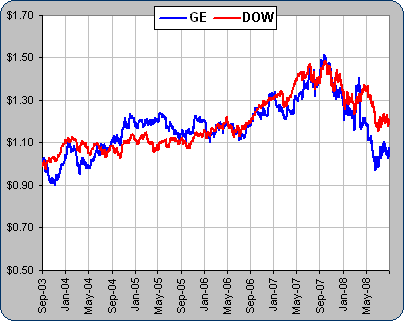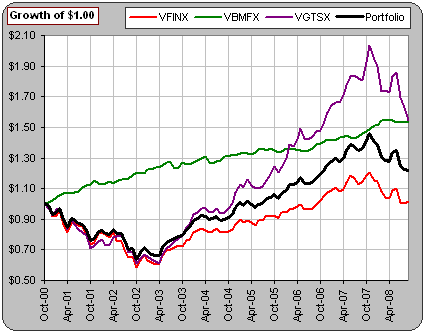| What to Invest in: diversification |
If you knew what stocks would perform well in the future, that's what you'd buy.
Alas, that information isn't available (and past performance won't help much).
So what to do, given our ignorance of the future?
We might take consolation in the comment of Warren Buffett (perhaps the greatest of modern investors).
Diversification is a protection against ignorance
Diversification means you'd invest in stocks (domestic and foreign) and/or bonds and/or mutual funds
... a variety of assets that don't all move in the same direction.
|
Suppose you invested in, say GE (General Electric) and the DOW.
Then you'd find that they tend to go up and down together. What's good is that, in good times, they both go up. What's bad is that, in bad times, they both go down. 
It's that going down together that you'd want to avoid
That's "diversification". |  |

|
Look at a portfolio of Vanguard Funds:
60% in VFINX (tracking the S&P500) 30% in VGTSX (investing in Europe, the Pacific and emerging markets) 10% in VBMFX (investing in a broad assortment of bonds) The growth of the Portfolio may not be the best, but it ain't the worst either.
>Fairly steady?
|  |
If one asset outperforms and if you wish to maintain a 60:30:10 ratio (for example), you'd have to sell the better performers and buy more of the poorer performers.
That's rebalancing and you may want to do that monthly or yearly or perhaps when the allocations deviate too much from your "ideal" allocation.
When you start a Portfolio you'll (probably) contribute periodically. If you get paid monthly, you'll (probably) add to your holdings on a monthly basis.
If you wanted to maintain a particular allocatiun, then that'd be a good time to buy the poorer performers to increase their portfolio weight.
If you really want to feel good about your monthly contributions, you'll call your investment ritual Dollar Cost Averaging.
But DCA has a Dark Side that you should be aware of. (See Poor Joe)
Arguments abound for one ritual versus another ... for example DCA vs Value Averaging
Indeed, many recommend investing All-at-Once ... just in case you come into a bunch of money.
You can play with DCA vs All-at-Once here.
See:
- DCA and a Magic Sum
- About rebalancing
- Rebalancing: yes or no?
- When to rebalance
- Asset Allocation
- Utility Theory
- Efficient Frontier
- Seasonality
- Magic rebalancing formulas and the Rebalancing Bonus
- Stock + Bond portfolios
- more Stock + Bond portfolios
- Best stock/bond mix (?)
- a Slice & Dice Portfolio
- Stutzer Index
- Black-Litterman ... which I don't understand &$%#@!?
|
|
 to continue
to continue